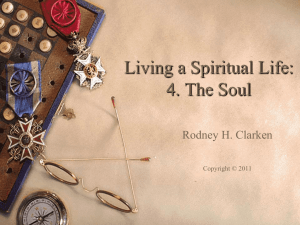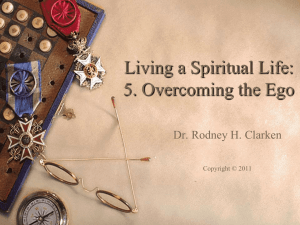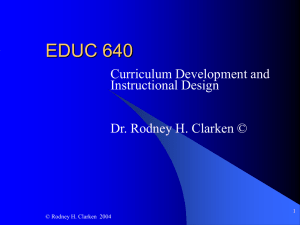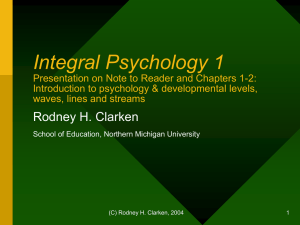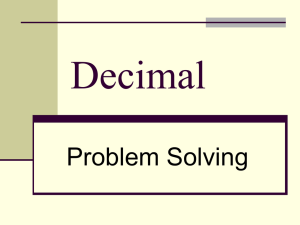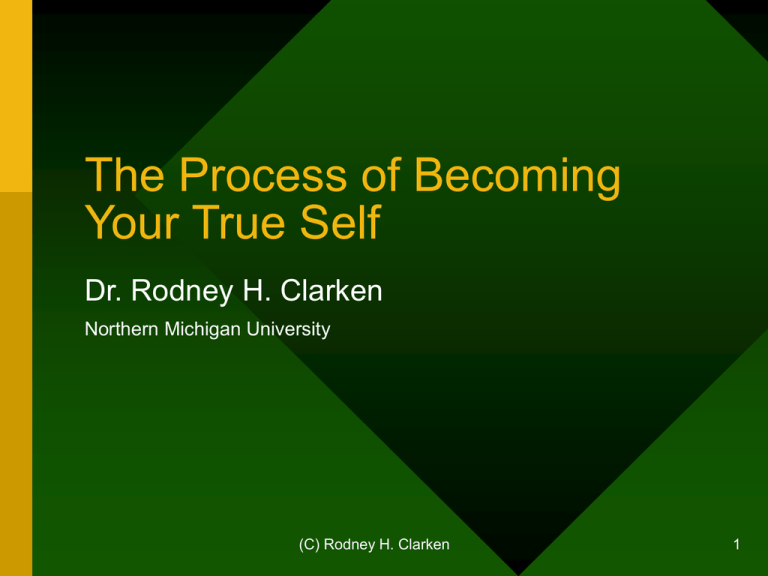
The Process of Becoming
Your True Self
Dr. Rodney H. Clarken
Northern Michigan University
(C) Rodney H. Clarken
1
The process of becoming your
true self is
• a model of human development based on
an integration of knowledge from
psychology, philosophy and religion.
(C) Rodney H. Clarken
2
It identifies knowing, loving and
willing
• as the three basic human capacities and
describes how they are developed
through the body, mind and soul.
(C) Rodney H. Clarken
3
It views the body, mind and
soul
• as the three basic natures of human
beings, that develop in hierarchical
stages in an individual from embryo to
adult (ontogeny) just as they did in the
evolutionary development of human life
(phylogeny) through the stages of
mineral, vegetable, animal (body), human
(mind) and beyond (soul).
(C) Rodney H. Clarken
4
•Know
•Mineral
•Vegetable
•Body
•Mind
•self
•Love
•Soul
•Spirit
•True Self
•Will
(C) Rodney H. Clarken
5
Your true self: the beginning
You are here
.
We all start of as a one-celled microscopic
organism, invisible to the human eye. That
is your true self at the initial stage of your
development, containing all your future
potentialities.
(C) Rodney H. Clarken
6
The process of becoming
How do we
get from here
.
To here
(C) Rodney H. Clarken
7
From the humble beginning
• of a one-celled being, we progress
hierarchically through all the kingdoms and
stages of development that we did in evolution:
• Mineral
• Vegetable
• Animal
• Human
(C) Rodney H. Clarken
8
Stages of Material
Development
•Mineral
•Vegetable
•Animal (Body)
•Human (Brain/Mind
Matter
(C) Rodney H. Clarken
9
These are the same stages
• that the world has gone through
evolutionarily over millions of years
• First, there was matter that formed into
minerals, that over time created the right
conditions for the evolution of plants, that
were followed by animals, which set the
stage for humans.
(C) Rodney H. Clarken
10
Hierarchy of material creation
Time
Human
Animal
Vegetable
Mineral
Matter
Relative abundance of realm
(C) Rodney H. Clarken
11
The human being is the latest
• and highest realm of creation,
incorporating in itself the qualities and
attributes of the earlier and lower
creations: mineral, vegetable & animal
• These physical developments that took
billions of years to accomplish in
evolution, we pass through in nine
months within the womb
(C) Rodney H. Clarken
12
Human nature
• The human being combines all the lower
levels of creation of mineral, vegetable
and animal in its body, and shares their
qualities.
• Humans add the element of mind, based
in a more evolved brain, and have the
capacity to transcend them all with its
soul.
(C) Rodney H. Clarken
13
Human Nature
Mineral
Vegetable
•Body Animal Physical
•Mind Human Mental
•Soul Divine Spiritual
Each higher level encompasses
and transcends the lower
(C) Rodney H. Clarken
14
Stages of human development
• The body, mind and soul each go through a
mineral, vegetable, animal and human stage of
development in the process of your realizing
their full potential.
• The true self is your soul endowed with full
spiritual powers.
• We will briefly explore each of these.
(C) Rodney H. Clarken
15
The stages of the body: 1. mineral
• We start off as one-celled organisms made up of
atoms and molecules held together like the atoms
and molecules of a mineral.
• Our one-cell divides into two, each successive
cell follows a similar pattern, then the cells begin
differentiating into different body parts and
integrating into patterns, like a mineral crystal.
• We do not lose the mineral qualities of cohesion
of our body until we die, when the atoms and
molecules break apart returning again to simple
matter.
(C) Rodney H. Clarken
16
The vegetable stage of body
• The fetus implants itself on the wall of the
uterus and draws nourishment from the host
mother through an umbilical cord. If uprooted,
we die.
• We grow from the one-celled seed, augmenting
in size, qualities and development until at birth
we have billions of cells and the organs to
move to the animal stage. This vegetative
quality cause us physical growth throughout our
lives.
(C) Rodney H. Clarken
17
The animal stage of body
• Adds the animal qualities of sensation and
movement.
• In the womb, the senses and capacities
common to animals are being developed, but
not yet actively used.
• At birth the physical body, which humans share
in common with animals, is able to begin
developing its sensorimotor capacities.
(C) Rodney H. Clarken
18
The human stage of the body
• What distinguishes humans from animals
is reason, which physically depends on
the developed brain which has evolved
over eons.
• Understanding the physical brain can
help us to understand the more abstract
and higher mind and its role in the body.
(C) Rodney H. Clarken
19
“Man finds himself in the
predicament that Nature has
• endowed him essentially with three brains
which, despite great differences in structure,
must function together and communicate with
one another. The oldest of these brains is
basically reptilian. The second has been
inherited from lower mammals, and the third is
a later mammalian development, which, in its
culmination in primates, has made man
peculiarly man.” (MacLean, quoted in Koestler, Ghost in the machine, pp. 277-78)
(C) Rodney H. Clarken
20
The Triune Brain
Reptilian brain
(brain stem) oldest
Paleomammalian brain
(limbic system) later
Neomammalian brain
(neocortex) latest
http://www.ezls.fb12.uni-siegen.de/mkroedel/paul_maclean.html
Based on MacLean
(C) Rodney H. Clarken
21
The reptilian brain
• As infants, we operate primarily from the oldest
part of our triune brains, the brain stem, which
roughly corresponds to the reptilian brain. It
controls internal functions, instinctive drives,
reflexes, sleep, arousal and impulses
• As we master and transcend some of these
internal primitive activities and forces, we
advance to higher animal functions
(C) Rodney H. Clarken
22
The paleomammalian brain
• We move to the higher more evolved limbic
system, the second oldest part of the brain, which
“processes information in such a way that it
becomes experienced as feelings and emotions,
which become the guiding force for behavior”.
(Jantsch, Self-organizing universe, p. 167)
• Very similar in organization, chemistry and
function to the paleomammalian brain of horses,
dogs and cats, and intimately connected to the
brain stem’s visceral and emotional functions
(C) Rodney H. Clarken
23
The neomammalian brain
• The neocortex constitutes the latest and
highest stage in evolution of the brain. It
encompasses the limbic system and the brain
stem.
• It is what distinguishes humans from animals
physiologically.
• It is the seat of thought and most voluntary
movements: mother of invention and father of
abstract thought.
(C) Rodney H. Clarken
24
Three brains in one
• Reptilian brain stem: controls muscles, balance
and autonomic functions, such as breathing
and heartbeat; is active, even in deep sleep
• Paleomammalian limbic system: concerned
with emotions and instincts, feeding, fighting,
fleeing, and sexual behavior
• Neomammalian neocortex: comprises higher
cognitive functions which distinguish humans
from animals
(C) Rodney H. Clarken
25
The triune brain as body, heart
and mind
• Body, brain stem, part of ourselves the regulates
systems in our body. Perceives itself in the lower
belly, the area of its major biological functioning
(i.e., hunger, sex)
• Heart, limbic system, the part of ourselves that
feels emotions. Perceives itself in the chest, the
area of it’s primary responsibility and sensory
awareness.
• Mind, neocortex, the part of ourselves we most
often think of as who we are. Perceives itself in
the head, the are that forms judgments, handles
short term memory
and does abstractions
(C) Rodney H. Clarken
26
Triune brain and the three basic
human capacities
• Body: to will, centered in brain stem
• Heart: to love, centered in limbic system
• Mind: to know, centered in neocortex
(C) Rodney H. Clarken
27
The knowing, loving and willing
process of becoming true self
•Knowing
Mind
•Loving
Heart
•Willing
Body
(C) Rodney H. Clarken
28
Each of the triune brains thinks
differently
• Body thinks in gestalt sequences of body
sensations; body consciousness
• Heart thinks in sequences of feelings;
emotional consciousness
• Mind thinks in sequences of words,
concepts, thoughts, logic, etc.; mental
consciousness
(C) Rodney H. Clarken
29
•Body Animal Physical
(Heart
Mammal
Emotional)
•Mind Human Mental
•Soul Divine Spiritual
Human Nature &
Triune Brain
(C) Rodney H. Clarken
30
The brain-mind connection
• The brain is the physical organ that is the seat of
the subjective mind, but the conscious mind is
different and distinct from the objective brain.
• First person (I) subjective mind (conscious
experience) reciprocally interacts with third
person (it) objective brain (neurological systems).
• The brain is in the body and the body is in the
mind.
Next, we will look briefly at one aspect of the stages
of the mind using Piaget’s cognitive model.
(C) Rodney H. Clarken
31
Stages of the mind: 1. mineral
• The initial mineral stage of the mind is the
bonding in simple patterns of the elements of
sensations, perceptions, impulses, images, etc.
into a coherent mental representation.
• The mind is primarily sensorimotor and takes as
its object the sensorimotor realm. Its general
self-sense is material and physical.
(C) Rodney H. Clarken
32
Vegetable stage of the mind
• Here the mind grows and can reproduce mental
material. It is at the preoperational stage where
it can use language and symbols to grow, and
memory and imagination to reproduce, but only
in a non logical and non reversible way. The
mind does not grasp other points of view or
perspectives. It has not developed its animal
sensibilities.
(C) Rodney H. Clarken
33
Animal stage of the mind
• The animal stage of mind can sense and move
with and within the mind without the need of
material senses and movement. Here the mind
can see and hear for itself, without physical
eyes or ears. This is the concrete operational
stage where the mind can conserve and can
logically and systematically manipulate symbols
related to concrete objects.
(C) Rodney H. Clarken
34
Human stage of the mind
• The mental mind, where the mind can think
about itself and reflect upon and represent non
material (abstract) reality. This stage is
represented by formal operations: logical
manipulation of symbols related to abstract
concepts. It takes as it object the world of
thought and is creative, constructive and
systematic.
(C) Rodney H. Clarken
35
Soul stage of the mind
• When the mind reaches the soul stage,
the mind transcends itself and is
illumined by the soul which lead to higher
authentic, autonomous, unified, visionary
and intuitive thinking. The mind becomes
post logical, rational, personal, verbal,
etc., no longer limited by those mental
constructs.
(C) Rodney H. Clarken
36
What is the soul?
• \Soul\ The animating and vital principle
in humankind credited with the faculties
of thought, action and emotion and
conceived as forming an immaterial entity
distinguished from but temporally
coexistent with the body.
Dictionary
(C) Rodney H. Clarken
37
“an animating and vital
principle”
• Energy; courage; spirit; fervor; affection,
or any other noble manifestation of the
heart or moral nature; inherent power or
goodness. Definition 4 of soul from Webster's Revised Unabridged
Dictionary
• The soul is like the sun which illumines,
sustains and is reflected in the body and
mind.
(C) Rodney H. Clarken
38
“faculties of thought, action
and emotion”
• Thought (Mind): Knowing, Thinking
Understanding TRUTH
• Action (Body): Willing, Doing
Justice GOOD
• Emotion (Heart): Loving, Feeling
Unity BEAUTY
(C) Rodney H. Clarken
39
“an immaterial entity”
• \Im`ma*te"ri*al\ 1. Not consisting of matter;
incorporeal; spiritual;
• \Spir"it*u*al\ 1. Consisting of spirit; not material;
incorporeal; 2. Of or pertaining to the intellectual
and higher endowments of the mind; mental;
intellectual. 3. Of or pertaining to the moral
feelings or states of the soul, as distinguished
from the external actions; reaching and affecting
the spirits. 4. Of or pertaining to the soul or its
affections as influenced by the Spirit;
(C) Rodney H. Clarken
40
“distinguished from but
temporally coexistent with the
body”
• The soul is different and distinct from the body,
but associated with the body for the limited time
of its life
• The body is like a horse and the soul is like the
rider. At one level we identify with and care for
the body as it is the vehicle for the soul, our
true identity, which exists after the body dies.
(C) Rodney H. Clarken
41
The soul is like an embryo
• As an immaterial entity it is hard to
comprehend. We can use material metaphors
to help us understand what it is and how it
works
• The development of the embryo is analogous to
the development of the soul. As the embryo
develops all the physical attributes for this
world, the soul develops spiritual attributes for
the next.
(C) Rodney H. Clarken
42
The womb of this world
• Just as the body develops all of it physical
capacities while in the womb of its mother, the
soul develops its spiritual capacities while in the
womb of this world. The human body serves as
the placenta to the soul, taking in and filtering
the nourishment of the world so that the soul
can develop the spiritual qualities and
characteristics needed in the next realm.
(C) Rodney H. Clarken
43
Stages of the soul
• The stages the soul go through can be
compared to the stages the embryo goes
through: mineral to vegetable to animal to
human.
• Though the soul is a non material entity,
we can compare the spiritual
development of the soul to the material
development of the body.
(C) Rodney H. Clarken
44
Mineral stage of the soul
• At conception, the soul comes into being. It
might be compared to the simple one-celled
organism of the body. It has all of the capacities
inherent in it, but they have yet to be
developed. Initially the soul in the mineral stage
can be conceived of as the cohesion of atoms
and molecules of spirit and virtues binding
together to make a new entity, a unique spiritual
identity, just as the body is a unique physical
identity.
(C) Rodney H. Clarken
45
Vegetable stage of soul
• “As interpreted by the Scholastics, the
vegetative soul was common to plants,
animals, and humans; the sensitive soul
was common to animals and humans;
and the rational soul was found only in
humans. “Vegetable love” is thus a love
that grows, takes nourishment, and
reproduces, although slowly.” The American Heritage
Dictionary
(C) Rodney H. Clarken
46
Animal stage of soul
• At this stage the human soul adds the
capacity of sensation to the earlier
mineral spirit of cohesion and the
vegetable spirit of growth and
reproduction: we see, hear and feel with
our soul, in a similar way that we can first
see, hear and feel with our physical
senses, then later with our mental.
(C) Rodney H. Clarken
47
Human stage of the soul
• The soul at this stage can reason and
think for itself, transcending the
knowledge from the physical and mental
realms. It uses but is not bond by the
body and mind as in earlier stages. This
is the mental stage of the soul, the
rational soul, that can imagine, discover
and comprehend the mysteries of this
material world(C) and
advance civilization.
Rodney H. Clarken
48
Soul stage of the soul
• The soul can differentiate and integrate all
experiences from all the stages from mineral
to soul and can witness reality from a level
of knowing, loving and willing that
transcends the material and mental realms.
Here we receive the heavenly illumination;
understand spiritual reality; comprehend the
mysteries of eternal life and come to know,
love and obey God.
(C) Rodney H. Clarken
49
Spirit stage of the soul
• The soul can transcended itself merging
with the Great Holy Spirit, freeing itself of
all physical, mental and spiritual
attachments, such as attachment to the
virtues and names of the Divine Creator,
rather than to the Ultimate Infinite
Essence that transcends all limitations
and divisions.
(C) Rodney H. Clarken
50
How do negotiate these stages?
• Using our knowing, loving and willing
capacities through our body, minds and
souls.
• The following figures and charts will
present some correlates of these to help
us understand how we might use them to
further the process of becoming our true
selves.
(C) Rodney H. Clarken
51
•Know
•Mineral
•Vegetable
•Body
•Mind
•self
•Love
•Soul
•Spirit
•True Self
•Will
(C) Rodney H. Clarken
52
•Knowing
•Thinking
•Truth
•Head
•Understanding
•Science
mind
•Loving
soul
body
•Feeling
•Beauty
•Heart
•Unity
•Arts
•Willing
•Doing
•Good
•Hand
•Justice
•Morals
(C) Rodney H. Clarken
53
Table 2. Some correlates of
knowing, loving and willing
Know
Love
Will
Consultation/
Investigation
Compassion/
Caring
Creation/
Construction
Think
Feel
Do
Authenticity
Altruism
Autonomy
Truth
Beauty
Good
(C) Rodney H. Clarken
54
Understanding
Unity
Justice
Head
Heart
Hand
Cognitive
Affective
Conative
Mind
Soul
Body
Reason
Compassion
Courage
(C) Rodney H. Clarken
55
Logic/
Epistemology
Aesthetics/
Axiology
Ethics/ Ontology
Objective (It)
Subjective (I)
Intersubjective
(We)
Science
Arts
Morals
Agencypreservation
Erostranscendence
Communionadaptation
Differentiate
Integrate
Transcend
Pure Reason
Aesthetic
Judgment
Practical Reason
(C) Rodney H. Clarken
56
Table 2: Some correlates of body,
mind and soul
Nature
Body
Mind
Soul
World
Physical
Mental
Spiritual
Kingdom/
Realm
Animal
Human
Divine
Food
Nutrition
Knowledge Virtues
(C) Rodney H. Clarken
57
Symbol
Hand
Head
Heart
Reality/
Spirit
Objective
Subjective Transcendental
Language Pre VerbalBody, Cries
VerbalWords
Post VerbalDeeds
Logic
Pre Logical
(magic)
Logical
(reason)
Trans Logical
(inspiration)
Reason
Pre Rational
(drives)
Rational
Post Rational
(empirical) (certitude)
(C) Rodney H. Clarken
58
Perspective 1st, person,
2-3rd person,
Pre
conventional
conventional
Source
Nature
Science
4th and on
post
conventional
Religion
Identity
Pre Personal
(physical,
emotional)
Conscious- Subness
Conscious
Personal
(ego, ethnic)
SelfConscious
Transpersonal
(universal,
transcendenta
SuperConscious
Sphere
Noosphere
Theosphere
Biosphere
Self Center Bio centric
EgoWorld
(C) Rodney H. Clarken
centric
Theo centric
59
•Know
•Body
•Mind
•Soul
•self
•Love
•True Self
•Will
(C) Rodney H. Clarken
60
References
• This presentation has drawn from the
works of Baha’u’llah, Abdu’l-Baha and
Ken Wilber. I refer you to their writings for
more breadth, depth and clarity on these
topics.
(C) Rodney H. Clarken
61
Contact information
Dr. Rodney H. Clarken
Director of Field Experiences and Professor, School of
Education, Northern Michigan University, 1401
Presque Isle Avenue, Marquette, MI 49855-5348
Tel: 906-227-2160 (secretary), 227-1881 (office), 2262079 (home), Fax: 227-2764
Website with info on courses, papers, Baha'i and
China and this presentation: http://wwwinstruct.nmu.edu/education/rclarken
(C) Rodney H. Clarken
62


